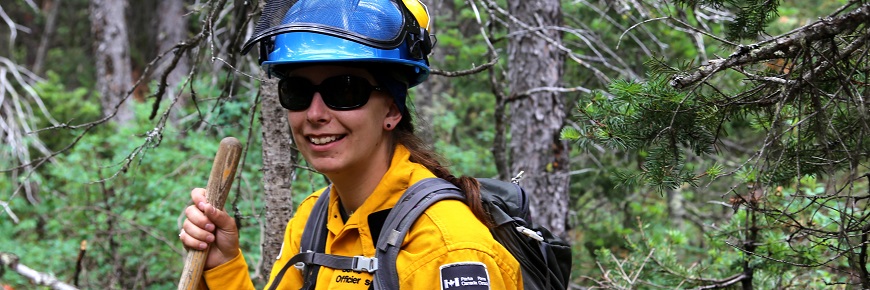
Women in wildland fire
Pukaskwa National Park
by Stephanie Koroscil
Earlier this year, a new colleague asked me what it is like being a woman in such a traditionally male-dominated field, and if there were many women working in wildland fire within Parks Canada. In answering the question, I looked around and realised there are women represented at nearly every level within Parks Canada’s fire program and in most positions within the Incident Management Teams that manage large fires.
Additionally, at Pukaskwa National Park, there are many women working in ecological sciences and in management roles. I was excited to be able to tell my co-worker about the strong, female role models in field-based and management positions in Parks Canada.
It has long been recognised that women are underrepresented in the fields of science, technology, engineering and mathematics. As a young girl, nobody explicitly discouraged me from becoming a wildland fire fighter, but it was not an option that was presented to me either. I stumbled upon firefighting as a summer job to pay for university. I loved working outdoors and enjoyed the problem-solving aspects of emergency response. With each successive fire season, it became more and more clear that wildland fire management is where I want to make my career. Sometimes this work is dirty and physically challenging, like pulling hose off the fire line in the rain or hiking up the side of a mountain to check on a sprinkler line. There are mosquitoes and blisters, but I find the work very rewarding. With Parks Canada, I get to use fire as a landscape management tool – to create wildlife habitat, restore ecosystem health, and reduce the risk of wildfires to communities. I love what I do, but at times it has been difficult to recognise my own long-term potential because I did not see other women having long-term careers in wildland fire.
In recent years, I have noticed increasing media coverage on equality and gender diversity issues, and more open dialogue about these issues in wildland fire, as well. For example, in December 2016, an association of fire professionals released a position paper titled “Sexual Harassment and Gender Discrimination in Wildland Fire Management Must Be Addressed”. Then a little over a year later, wildland fire management agencies in Canada sent out a reminder about their commitment to abolish discrimination and harassment in the Canadian Wildland Fire Community. Around the same time, a popular American consumers’ co-operative, released a video entitled “Women in Fire” highlighting the work of many women in wildland fire careers and the importance of showing everyone, especially children, that this career is possible for anyone who wants to pursue it.
Seeing other women excelling in leadership roles within wildland fire has helped me believe that I can progress in this profession; it has changed my internal dialogue from “I will try” to “I will”. The increasing awareness of gender diversity challenges amongst the fire community has me hopeful that these positive culture shifts will continue in the future.
Check out Stephanie inspiring the next generation at the Canadian Bushplane Heritage Centre, Sault Ste. Marie, in 2015: Hot new fire exhibit!
Back to shoreLINES
- Date modified :